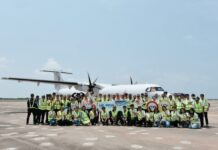The financial performance of airlines continued to improve in the fourth quarter of 2014, according to a report by the International Air Transport Association (IATA).
The association’s airlines financial monitor for December to January 2015 was released on 10 February, and uses data from 13 anonymous international carriers. “Initial quarter four financial results showed that the performance of airlines improved on the year ago period at the operating and net level,” the report explains.
IATA says carriers in North America drove the financial performance through consolidation and cost cutting, which has resulted in a significant boost to profitability. The eight that were sampled from the continent posted a year-on-year (YOY) net post-tax profit of $1.1 billion, up from the $976 million in quarter four in 2013. While it is not known if United Airlines was one of those anonymous data providers, in 2014, the carrier saw profits rise by 98.2 per cent to $1.1 billion. This is despite its fourth quarter profits falling by 80 per cent to $28 million. In the first quarter the airline made a loss of $609 million, before making profits of $789 million during the second quarter and $924 million in the third quarter.
The results follow IATA’s third quarter 2014 airlines financial monitor. It found that airlines made a net post-tax profit of $9 billion with North America having the strongest performance while Latin American carriers made a loss.
For the 10 February monitor, airlines sampled in Asia Pacific showed signs of recovery, but that could change as more results are reported, IATA explains. Results of the four airlines used, registered a YOY net post-tax profit of $349 million, an increase on the $322 million in 2013. “The [Asia Pacific] region’s financial performance has been weak for some time, hampered by over capacity and weakness in cargo revenues,” the report notes.
The one European carrier sampled posted a YOY net post-tax profit of $61 million, compared to the loss of $48 million in the same period 12 months ago. Overall, the 13 carriers sampled in the financial monitor recorded a net post-tax profit of $1.5 billion, $300 million more than the $1.2 billion that was recorded in the same quarter in 2013.
Examining the change between 2013 and 2014 in the freight tonne kilometres (FTK), available freight tonne kilometres (AFTK) and load factors, the financial monitor shows that the Middle East once again emerges as the leader with 11 per cent growth. However, Asia Pacific is not second, instead Africa pushes ahead with 6.7 per cent versus Asia Pacific’s 5.4 per cent.
The report also says there was a rise of one per cent in share prices of airlines in January, but this slowed compared to the four per cent in December. Shares in airlines increased by 40 per cent in 2014, boosted partly by falling energy prices in the latter months of the year. According to the report, declines in crude oil and aircraft fuel prices did stabilise in January after falling more than 50 per cent by the end of 2014. Meanwhile, airfreight demand also sustained recent gains despite a small contraction in December compared to November. Airfreight was driven by strong growth in emerging Asia trade activity, and in December this came despite developing concerns over the health of the global economy. As for cargo capacity, this expanded strongly in December after two months of no growth in the fourth quarter. There was solid expansion in AFTK last year and IATA explains that this was mostly the result of growth in capacity on airlines in the Asia Pacific region.
Airline fleets were boosted in December with the arrival of 168 aircraft deliveries, 29 more than the 139 delivered in November, while 71 aircraft went into storage in the month, down from 93 in November.
With so much capacity available, the load factor percentage fell in December, compared to the same month in 2013. “The growth in airfreight demand over recent months has supported some improvement in loads, but continued expansion in capacity through the passenger business had kept load factors low at just over 45 per cent,” the report says.












